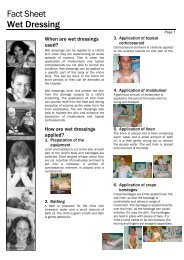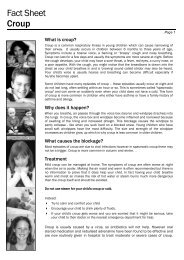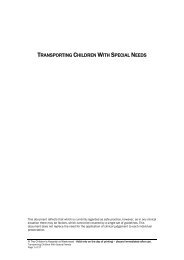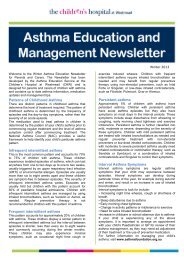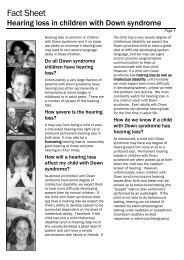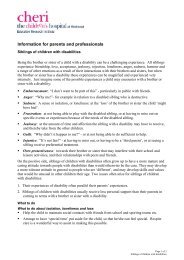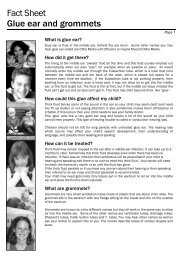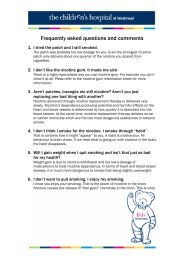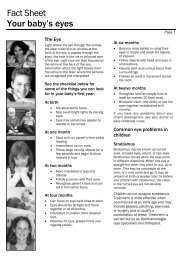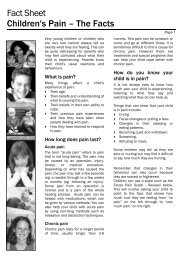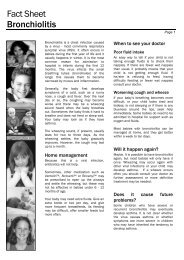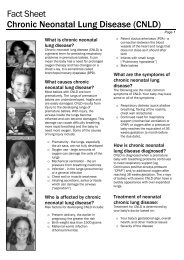PDF Version available - Kids Health @ CHW
PDF Version available - Kids Health @ CHW
PDF Version available - Kids Health @ CHW
You also want an ePaper? Increase the reach of your titles
YUMPU automatically turns print PDFs into web optimized ePapers that Google loves.
Fact Sheet<br />
Seizures and epilepsy<br />
xcvxcvxcv<br />
Page 1<br />
What is a seizure?<br />
Seizures are caused by a short burst of abnormal electrical activity in the brain. This is<br />
when the nerve cells send “mixed-up” signals to each other. These mixed-up signals<br />
may lead to a change in the child‟s awareness or body movement. Sometimes people<br />
use other names for seizures such as convulsions or fits.<br />
What causes seizures?<br />
Seizures can be provoked by many conditions. Some examples are after a head injury,<br />
or associated with high fever in a child under 6. (See also the fact sheet on “Febrile<br />
Convulsions”). If your child has had their first seizure the medical team will look for<br />
reasons why the seizure occurred.<br />
What is Epilepsy?<br />
Epilepsy is a condition with repeated seizures without fever. Epilepsy is a broad term<br />
that includes the many reasons why a child may have repeated seizures. Epilepsy is not<br />
contagious. It is impossible to “catch” epilepsy.<br />
Most cases of epilepsy in children are successfully treated with medication.<br />
How common are seizures and epilepsy?<br />
Seizures are fairly common in children. Around 5% of children will have had at least one<br />
seizure by the time they are 15. Epilepsy is less common. Only about 1% of children<br />
have epilepsy. Anyone can have epilepsy regardless of their age, sex or intelligence.<br />
Many children will grow out of their epilepsy.<br />
Types of Seizures<br />
There are different types of seizures. Different types of abnormal electrical activity in<br />
the brain cause differences in the way a seizure looks.<br />
Generalised seizures are caused by abnormal electrical activity involving the whole<br />
brain at the same time.<br />
Types of generalised seizures:<br />
Absence (Brief loss of awareness)<br />
Myoclonic (single muscle jerk)<br />
Clonic (repetitive jerking of muscles)<br />
Tonic (stiffening of muscles)<br />
Tonic-Clonic (stiffening and jerking of muscles)<br />
Partial seizures are caused by abnormal electrical activity starting in a particular part of<br />
the brain. These may also be called focal seizures.<br />
Simple Partial (child is fully aware)<br />
Complex Partial (child has altered awareness)<br />
In a simple partial seizure the child is fully aware, but may have abnormal sensation or<br />
movement of part of their body.
Fact Sheet<br />
Seizures and epilepsy<br />
xcvxcvxcv<br />
Page 2<br />
During a complex partial seizure the child has altered awareness. The child may<br />
be unresponsive or appear “day dreamy”. The child may make inappropriate<br />
movements such as fiddling with clothes or „smacking‟ their lips.<br />
Diagnosis of Epilepsy<br />
An accurate diagnosis of epilepsy is essential so that the most appropriate<br />
treatment can be given. Your child should be seen by a children‟s specialist<br />
doctor (paediatrician) or by a doctor who specialises in epilepsy (paediatric<br />
neurologist). The diagnosis of epilepsy relies on the accurate description of the<br />
events (seizures) as well as a detailed medical history including childhood<br />
development, behaviour and learning abilities. If possible a home video recording<br />
of the events (seizures) can be very helpful to the doctor.<br />
What tests are needed?<br />
Various tests may be used to investigate the cause of a seizure. This will depend<br />
on the type of seizure, age of your child, and the general health of your child. The<br />
most important part of the investigation is often the eye-witness description of the<br />
seizure. Depending on your child‟s history other tests may be needed. These may<br />
include blood tests, imaging of the brain such as CT scan or MRI scan and an EEG<br />
(electroencephalogram) which records the electrical activity of the brain.<br />
Could the seizure be something else?<br />
Sometimes other symptoms can be mistaken for seizures, for example faints or<br />
simple staring. Your child‟s doctor will work through the investigations to find the<br />
right diagnosis.<br />
Will a seizure harm my child?<br />
Most children recover well from a seizure. Rarely a prolonged seizure, lasting<br />
more than 30 minutes, may cause problems. Often the biggest risk to your child‟s<br />
safety is not the seizure itself, but the situation in which the seizure occurs. It is<br />
important that children at risk of a seizure are always well-supervised around<br />
water activities such as bathing and swimming.<br />
Will my Child need medication?<br />
Your doctor may advise that your child takes regular medication if they have<br />
repeated seizures without fever. Most children with epilepsy can be treated with<br />
one medication taken once or twice a day for a period of about two years.<br />
Are there other treatments <strong>available</strong>?<br />
If your child‟s seizures are not well controlled by medication a variety of other<br />
treatments sometimes help.<br />
1) If it can be shown that the seizures come from one area of the brain,<br />
surgical removal of that part of the brain may stop or significantly reduce<br />
the seizures.
Fact Sheet<br />
Seizures and epilepsy<br />
xcvxcvxcv<br />
Page 3<br />
2) In other cases a special diet, high in fat and low in carbohydrates may be<br />
effective.<br />
3) Vagal nerve stimulation where a specially inserted electrical device<br />
stimulates a nerve in the neck may be used when other treatments fail or<br />
are not suitable.<br />
What can I do to help my child during a seizure?<br />
There are some simple steps that you can take during a seizure to provide first<br />
aid.<br />
First Aid for Seizures of Altered Awareness – eg absence seizures or complex<br />
partial seizures<br />
Stay calm.<br />
Note the time the seizure starts and ends if possible.<br />
Stay with your child and watch your child to protect them from potentially<br />
harmful situations. For example stop them from walking onto a nearby<br />
road.<br />
First Aid for Convulsive or Tonic-Clonic Seizures<br />
Stay calm.<br />
Note the time the seizure starts and ends if possible.<br />
Stay with your child, roll them onto their side, also known as the recovery<br />
position.<br />
Move away from potentially harmful objects eg furniture with sharp<br />
corners.<br />
Place something soft under your child‟s head to stop their head hitting the<br />
floor.<br />
Never place anything in the mouth of your child – it is impossible for your<br />
child to swallow their tongue.<br />
Your child may become tired after the seizure. Allow them to rest and<br />
recover.<br />
Is there any treatment <strong>available</strong> if my child has frequent<br />
or prolonged seizures<br />
There is a medication called midazolam that may be recommended for children<br />
who have frequent or prolonged seizures that last longer than 5 minutes. Most<br />
children do not require this medication.<br />
Should I take special precautions?<br />
Don't let your child swim alone and make sure there is an observer watching them<br />
closely. The observer needs to be a strong swimmer.<br />
Encourage your child to have showers instead of baths and never leave the child<br />
alone in the bath.<br />
Make sure adults or older children who look after your child know what to do if<br />
your child has a seizure.
Fact Sheet<br />
Seizures and epilepsy<br />
xcvxcvxcv<br />
This fact sheet is for education purposes only.<br />
Please consult with your doctor or other health professional<br />
to make sure this information is right for your child. This document was reviewed on 25 th November 2011<br />
The next date of review for this document is 25 th<br />
November 2013<br />
www.chw.edu.au www.sch.edu.au www.kaleidoscope.org.au<br />
Page 4<br />
Activities involving heights are best avoided unless your child‟s safety can be<br />
secured.<br />
Should I call an ambulance?<br />
Call 000 for an ambulance if:<br />
It is your child‟s first seizure.<br />
The seizure lasts longer than 5 minutes.<br />
The seizure occurs in water and your child has trouble breathing.<br />
Your child also has a head injury.<br />
Your child‟s breathing doesn‟t return to normal shortly after the seizure or<br />
your child remains blue around the lips.<br />
You are unsure that your child is safe and recovering normally after the<br />
seizure.<br />
First Aid courses:<br />
First aid training can be valuable for everyone who cares for children. First aid<br />
courses are often run by local community health centres, and other organisations<br />
such as the Australian Red Cross and St John‟s Ambulance.<br />
St John‟s Ambulance www.stjohn.org.au ph: 1300 360 455<br />
Australian Red Cross www.redcross.org.au ph: 1300 367 428<br />
Where can I get more information on epilepsy?<br />
Contact Epilepsy Action 1300 374 537, or visit their website www.epilepsy.org.au.<br />
Remember:<br />
Seizures are caused by a short burst of abnormal electrical activity in the<br />
brain.<br />
Epilepsy is a condition which involves repeated seizures without fever.<br />
Understanding the problems and heeding medical advice enables your child<br />
to do almost all of the things they may choose to do and to have a very<br />
productive life.<br />
© The Children’s Hospital at Westmead, Sydney Children’s Hospital, Randwick & Kaleidoscope * Hunter Children’s <strong>Health</strong> Network – 2005-2011



